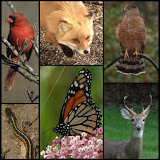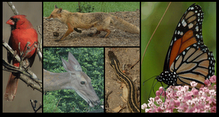Saturday morning, early spring. The usual songbirds at the feeders and on the ground. But at the opposite side of the Habitat, an immature red-shouldered hawk is on the ground. Why? No a clue, three times he came down from a maple tree branch less than ten feet up. Clearly, no mouse, no small bird. Nothing. He cries a few times; he clearly observes me as I approach and get to within 35 feet from him. Cleck to see an enlarged photo.
 Then, the young hawk seeks altitude in the sky and is joined by an older red shouldered. They scream loudly as they fly around and through a number of pine trees, then fly upward and perched about 50 feet in an oak tree. eNature says, “Normally shy, [the red-shouldered hawks] become tame if they are not persecuted and in some places may nest in suburban areas. During courtship a pair can be quite noisy, wheeling in the sky above their nesting territory and uttering their distinctive whistled scream.” Are these two parent and child? Or, are they a possible mating pair?
Then, the young hawk seeks altitude in the sky and is joined by an older red shouldered. They scream loudly as they fly around and through a number of pine trees, then fly upward and perched about 50 feet in an oak tree. eNature says, “Normally shy, [the red-shouldered hawks] become tame if they are not persecuted and in some places may nest in suburban areas. During courtship a pair can be quite noisy, wheeling in the sky above their nesting territory and uttering their distinctive whistled scream.” Are these two parent and child? Or, are they a possible mating pair?
 The trees in the Colvin Run Habitat provide cover and draw many birds, including the hawks. The trees, however, remain one of the greatest challenges to photographing any of the birds. The autofocus of the digital camera does not differentiate between tree branches in the foreground and hawks in the background. Focus, whether automatic or manual, becomes even more challenging with the telephoto zoom lens that I am using. I should stop complaining - in six weeks, the leaves will be back and none of these photos will be possible.
The trees in the Colvin Run Habitat provide cover and draw many birds, including the hawks. The trees, however, remain one of the greatest challenges to photographing any of the birds. The autofocus of the digital camera does not differentiate between tree branches in the foreground and hawks in the background. Focus, whether automatic or manual, becomes even more challenging with the telephoto zoom lens that I am using. I should stop complaining - in six weeks, the leaves will be back and none of these photos will be possible.
 As the immature red-shouldered left the ground I got the last photo. The inclusion of the two trees in the photo allows me to get a good estimate of the raptor’s wingspan. The distance between the two trees on the right and on the left of the photo is eight feet. That makes the hawk’s wingspan at least four feet.
As the immature red-shouldered left the ground I got the last photo. The inclusion of the two trees in the photo allows me to get a good estimate of the raptor’s wingspan. The distance between the two trees on the right and on the left of the photo is eight feet. That makes the hawk’s wingspan at least four feet. 

























